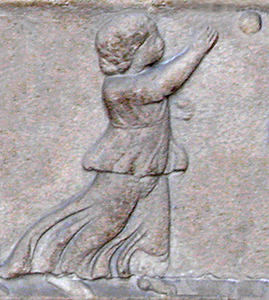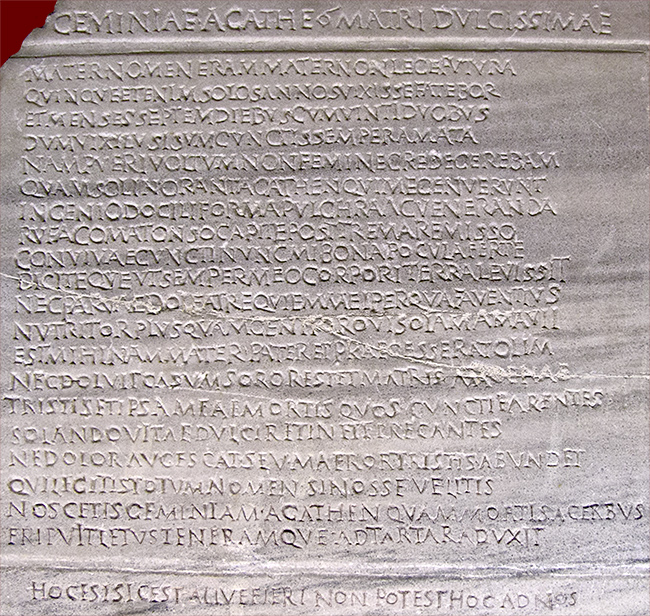Funerary Inscription for Geminia Agathe, CIL 6.19007

detail, Roman sarcophagus, 2nd century CE
Geminia Agathe died at the age of five in the city of Rome some time in the second century CE, her passing commemorated by a
marble funerary tablet
with two carved wings (tabula ansata),
each containing a letter (D and M). The tablet is rather plain, with a
lengthy inscription in the center carved in cramped, uneven letters,
but the content of the inscription is remarkable. Someone felt that this
little girl deserved more than a conventional epitaph and laboriously
composed a twenty-line poem in dactylic hexameter. Unlike the poem on the
altar of three-year-old Aelia Sabina,
where the poetic diction and
mythological allusions suggest a hired versifier, Geminia Agathe's poem
was a labor of love rather than skill. The meter is heavily spondaic,
and eight lines
(3, 5, 8, 10, 11, 15, 19, 20) will scan only with incorrect vowel
quantities and/or contracted syllables. But the poem paints a vivid
picture of a
lively little tomboy, easily mistaken for a boy, who loved her life of
games and sports. Except for a single mention of beauty (forma pulchra),
this inscription avoids the gender-specific feminine qualities
emphasized in most epitaphs for females, even female children. The poem
is written in
the voice of Agathe, and its entire focus is on her, with others
described from her perspective. She is even presented as the bringer of
solace to
her family, asking them to remember the happiness of her life instead of
grieving too much. Who was this unusual little girl? The
introductory dedication calls her Geminia Agathe Mater, though Mater was
obviously a nickname, as line 19 indicates. The inscription
contains none of the usual indications of status for herself or her
family, but we can make some educated deductions based on the names
(see names of freedpeople).
The gens Geminia is well-attested in Rome, but her Greek cognomen,
Agathe, would not typically be used in a free citizen family of any
status.
Because of her young age, she was probably freeborn but into a family of
freedpersons who were not necessarily citizens. Her mother's name,
Amoena, suggests that
she was likely a freedwoman, though the inscription does not give her nomen, and Agathe's deceased father is not named at all. Agathe lived with
her mother and her mother's unnamed sister, probably also a freedwoman, and a man named Faventius, a cognomen attested for slaves and freedpersons.
Faventius may have been a freedman married to Agathe's mother, but it would seem very odd to call a stepfather nutritor, the term used for
a male child-minder, corresponding to the female nutrix. More likely, he was a slave or freedman in the familia
assigned to take care of little
Agathe, perhaps the only servant they had, thus accounting for the fact
that a female child had a male caregiver. It is even possible that he
composed the
poem, since he is mentioned before Agathe's mother, father, and aunt,
and since his love for his little charge is so strongly stressed.
Whoever the author was,
he or she has succeeded in making Geminia Agathe unforgettable.

 MATRI
MATRI
No comments:
Post a Comment